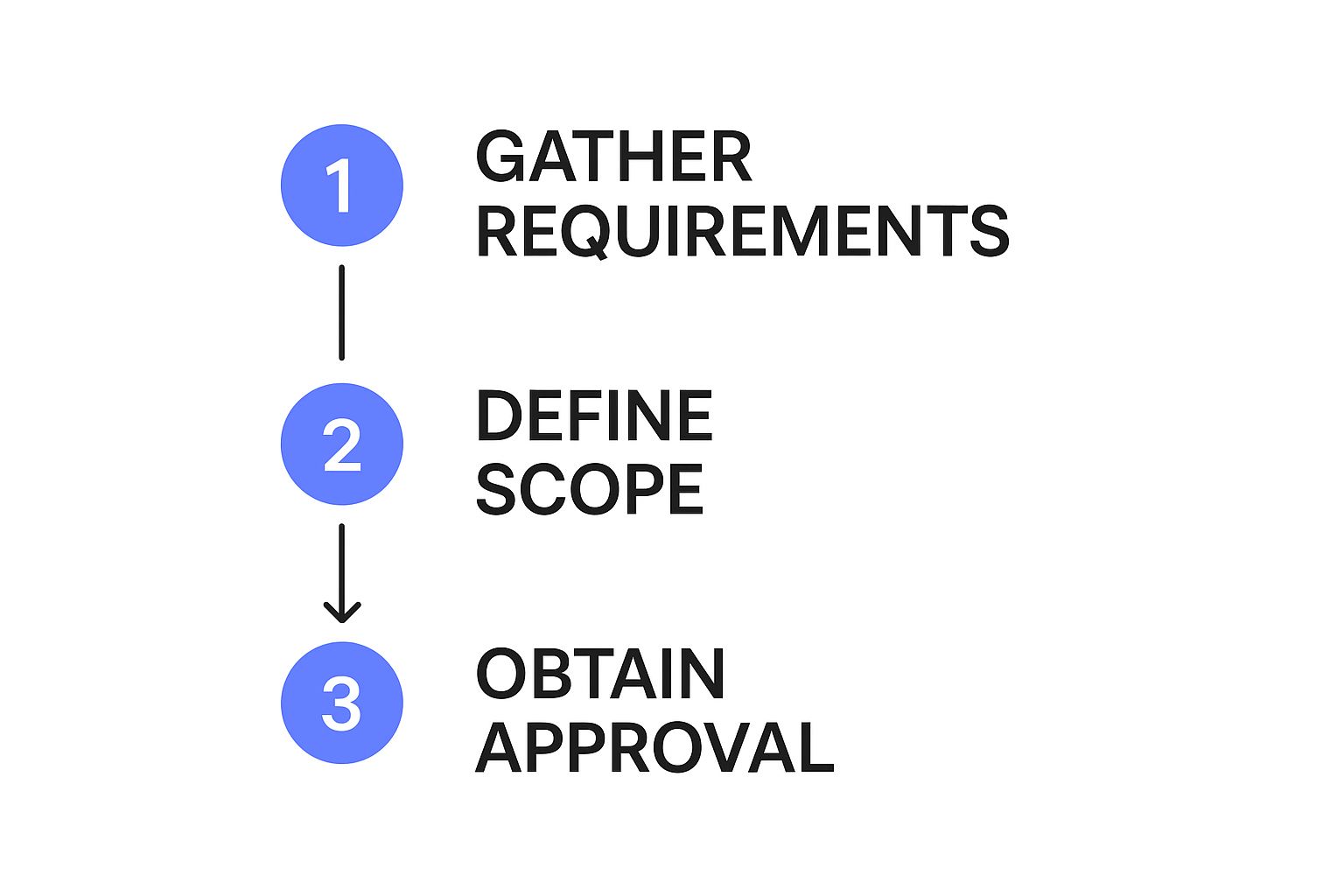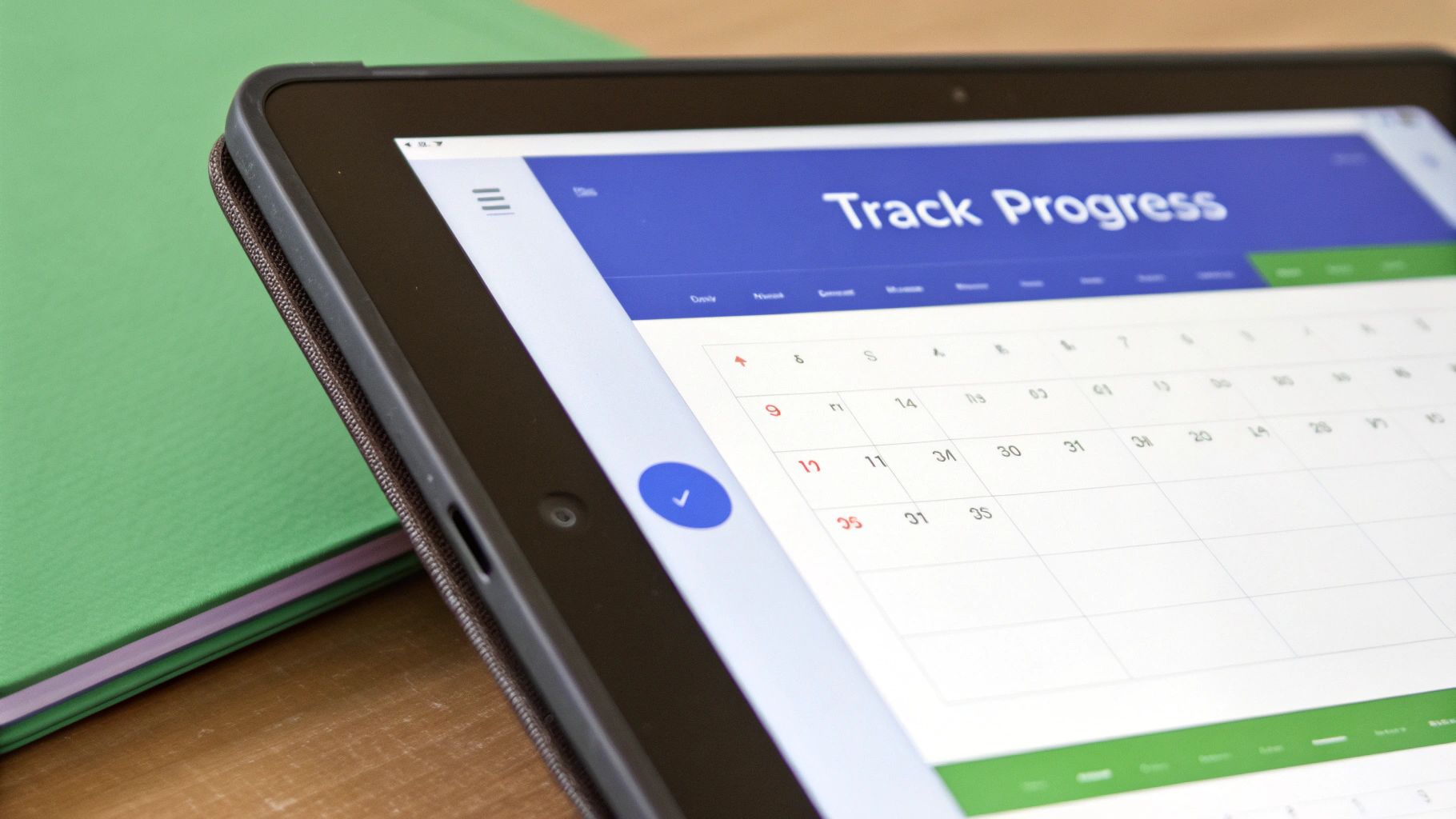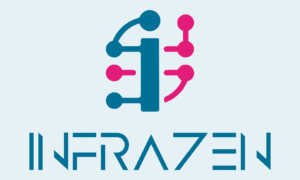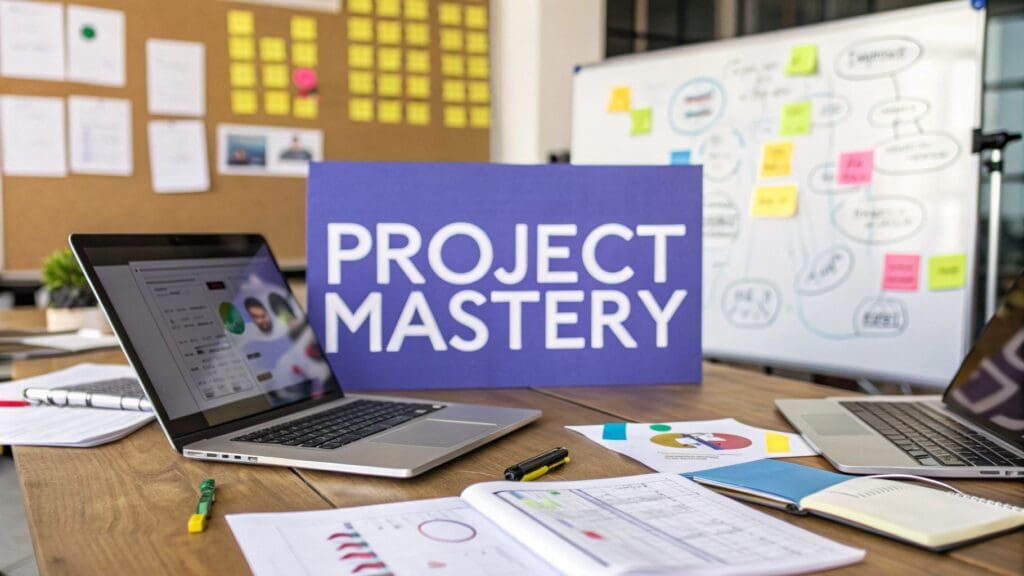Effective project management in a creative agency isn’t just about ticking boxes and hitting deadlines. It's the art of turning brilliant, chaotic ideas into profitable, polished work that makes clients happy. It’s the essential discipline that brings structure to creativity without stifling it.
The Real Challenges of Agency Project Management

Let’s be honest: managing projects in a creative agency is a unique kind of juggling act. You're constantly balancing artistic vision against client demands, tight deadlines, and even tighter margins. Creative work is fluid and subjective by its very nature, which is why those rigid, traditional project management playbooks just don't work here.
The stakes are incredibly high. Tiny inefficiencies can quickly add up, leading to serious financial leaks and unhappy clients. For UK agencies today, strategically aligning projects with your core business goals isn't just a "nice-to-have"- it's a matter of survival. One of the biggest culprits is scope creep, which can completely derail timelines and eat through budgets. Knowing how to avoid scope creep is a non-negotiable skill for keeping projects on the rails.
Navigating High-Stakes Environments
The pressure cooker gets even hotter when you consider how complex modern creative projects have become. A single campaign might involve web design, video production, a social media blitz, and a paid advertising strategy- all with their own timelines and dependencies. Without a solid system, it's terrifyingly easy for crucial details to slip through the cracks, resulting in costly rework and strained client relationships.
This is especially true for a project’s digital assets. Protecting them with a solid security framework, often through https://infrazen.tech/managed-cyber-security-services/, is an essential layer of project management that’s too often overlooked.
The hard truth is that many UK agencies know the theory but struggle to put it into practice consistently.
We all know project management is a cornerstone of success. A staggering 80% of project managers agree that aligning projects with business goals is critical. Yet, for every pound spent, nearly 10% is wasted due to poor project performance. That's a huge gap between knowing and doing.
This guide is here to help you bridge that gap. We're going to break down the most common pain points and give you practical, actionable solutions built specifically for the creative world.
Common Agency Pain Points and Their Project Management Solutions
Before we dive deep, let's get a high-level view of the common headaches that plague creative agencies and the strategic solutions we'll be exploring. These are the recurring issues that keep agency owners and project managers up at night.
The table below summarises these frequent challenges and points to the project management strategies that can solve them.
| Common Agency Challenge | Strategic Project Management Solution |
|---|---|
| Ambiguous Client Briefs | Implementing a structured project kickoff process with detailed requirement gathering. |
| Unpredictable Scope Creep | Establishing a clear Statement of Work (SOW) and a formal change request system. |
| Inefficient Resource Allocation | Using visual tools to map team capacity and balance workloads effectively. |
| Communication Breakdowns | Creating centralised communication channels and standardised reporting routines. |
| Missed Deadlines & Rushed Work | Building realistic timelines with built-in buffers for revisions and unexpected delays. |
Think of this as your roadmap. By addressing these challenges head-on with the right strategies, you can transform your project workflows from a source of stress into a powerful engine for growth and creativity.
Building a Project Management Framework That Works
Let’s be honest: moving from chaotic workflows to predictable success means building a solid project management framework. But for creative agencies, the answer isn’t a rigid, one-size-fits-all rulebook. The real goal is to build a system that fits your unique rhythm, providing just enough structure to bring clarity without suffocating the creative spark that defines your work.
The right approach for your agency could be Agile, Kanban, or even a hybrid model that cherry-picks elements from different systems. Kanban, with its visual boards and focus on continuous flow, is often a fantastic starting point. It’s incredibly adaptable to shifting priorities- a daily reality in the creative world.
Laying the Foundation for Clarity
Before a single pixel is pushed or a line of copy is written, three things absolutely must be crystal clear: project requirements, scope, and stakeholder approval. Nailing these upfront is your best defence against the confusion and endless rework that absolutely drains profitability and morale. Think of a standardised project kickoff as your secret weapon against ambiguity.
This process ensures that you and the client are on the same page, with expectations documented before your team invests their valuable time and resources.

Seeing the flow like this just reinforces its importance. Each step builds directly on the last, creating a stable foundation for the entire project. This methodical start is what separates the pros from the amateurs in creative agency project management.
Defining clear roles and responsibilities is another cornerstone of a functional framework. When everyone knows exactly what they own, decisions happen faster and accountability becomes second nature. There should never be a question about who gives final sign-off on a design or who’s in charge of client updates.
A well-defined framework does more than just organise tasks- it creates psychological safety. When creatives know the boundaries and expectations, they feel more confident to experiment and produce their best work within those lines.
For a deeper dive into establishing a robust framework, it's worth exploring comprehensive resources like The Ultimate Guide to Project Management for Agencies.
Establishing Effective Communication and Ownership
Look, your framework is only as good as the communication that powers it. Vague feedback, missed messages, and those soul-destroying email chains are project killers. Your system must define specific channels for different types of communication.
- For daily updates: A dedicated project management tool or a specific Slack channel keeps everyone in the loop without the noise.
- For formal feedback: Implement a system where client notes are consolidated in one place. This is crucial for preventing contradictory requests from different stakeholders.
- For major decisions: Schedule brief, focused meetings. They need clear agendas and even clearer action items to be effective.
This structured approach to communication stops information from getting lost or misinterpreted. It cuts down on the background chatter, allowing your team to focus on what they do best: creating brilliant work. By establishing these ground rules, you build a system that supports your team, protects your margins, and helps you deliver exceptional work, every single time.
Choosing and Implementing the Right Digital Tools

Picking the right software for creative project management can feel like navigating a minefield. The market is packed with tools, and every single one claims to be the magic bullet for your agency’s problems. But here’s the thing: the priciest platform or the one with the longest feature list often isn't the best fit. Why? Because creative workflows are rarely linear.
Don’t get sidetracked by all the bells and whistles. Your focus should be on core functionalities that solve your team's biggest headaches. A tool’s real worth is measured by how well it supports your creative process, not by how many features it crams into its dashboard.
Core Features That Actually Matter For Creatives
For a creative agency, a generic to-do list just won’t cut it. You need something visual, collaborative, and flexible enough to handle the organised chaos of a creative project. Look for tools built with creative output in mind.
-
Visual Task Boards: Kanban-style boards give you an immediate, at-a-glance snapshot of where everything stands. Everyone from designers to account managers can see what's in the queue, what’s being worked on, and what's waiting for review. For creative minds, this is far more intuitive than a clunky spreadsheet.
-
Integrated Asset Proofing: The endless back-and-forth of emailing design files for feedback is a notorious productivity killer. Look for tools with built-in proofing. This lets clients and internal team members drop comments directly onto images, videos, or PDFs, keeping all the feedback in one place and creating a clear audit trail of every requested change.
-
Simplified Time Tracking: Let's be honest, nobody enjoys tracking their time. The best tools get this, integrating time tracking so seamlessly into tasks that it feels like part of the workflow, not a chore. This data is pure gold for figuring out project profitability and making invoicing a breeze.
Choosing the right tool is a massive step. Getting it properly integrated into your daily operations is a cornerstone of your agency's growth- a process you can dive into with our guide on building a digital transformation roadmap.
Overcoming The Adoption Hurdle
Even the most incredible piece of software is useless if your team won’t touch it. Poor adoption is the number one reason new tool rollouts fail. The secret isn't to force it on them, but to show them exactly how it makes their lives easier.
A tool should serve your people- not the other way around. The goal is to find software that cuts down on admin friction, freeing up your team's time and mental energy to focus on what they're brilliant at: being creative.
For example, show your design team how integrated proofing kills off those confusing, 50-reply email chains. Show your project managers how automated reports save them hours of pulling numbers together by hand. Frame the new tool as a shield that protects their focus and creativity.
The appetite for these tools is huge across the UK, but so are the barriers. In fact, a staggering 19% of UK businesses want to bring project management software into their strategies but feel they don't have the skills or resources to do it right. This just proves how vital a thoughtful, people-first implementation plan really is. You can find more stats like this over on localiq.co.uk.
Start small. Roll out one or two key features, provide hands-on training, and actually listen to the feedback you get. When your team starts to see the software as a partner in their success, genuine adoption will naturally follow.
Leading Creative Teams in a Hybrid Workplace
At its heart, project management in a creative agency is a people-first job. This becomes glaringly obvious when you’re leading teams in a flexible, hybrid world. Success is no longer just about ticking off tasks and hitting deadlines; it’s about nurturing productivity, morale, and genuine collaboration, no matter where your team logs in from.
The move to flexible working isn’t some passing fad- it's now a core part of how UK creative agencies operate. Recent insights show a huge shift, with 61% of project workers reporting they worked from home at least one day a week in 2023.
What’s really telling is that project performance stays almost identical across the board, whether teams are fully remote (73.2%), hybrid (73.4%), or entirely in-office (74.6%). The data doesn’t lie: productivity isn’t tied to a physical postcode. Agencies can and do thrive, regardless of their setup. You can discover more project management statistics on plaky.com to see the full picture.
Fostering Genuine Collaboration Remotely
The biggest challenge? Creating a sense of real teamwork when people aren't breathing the same air. Those spontaneous brainstorming sessions by the coffee machine are a thing of the past, which means project managers have to be much more intentional about creating moments for connection.
One simple but effective approach is the "virtual open door" policy. Just set aside specific times when you’re available on a video call for anyone to drop in. No agenda needed. It mimics the easy accessibility of being in the office and stops small questions from ballooning into big problems simply because someone felt awkward about scheduling a formal meeting. For anyone leading creatives, mastering a few strategies to improve communication at work is non-negotiable for building a cohesive and successful team.
Maintaining Culture and Delivering Feedback
Agency culture can feel pretty diluted when your team is scattered. To fight this, project managers need to become champions for rituals that work remotely.
- Celebrate Wins Publicly: Create a dedicated Slack channel or a regular slot in the weekly team meeting to give shout-outs for great work. Public recognition is a powerful morale booster.
- Run Productive Check-ins: Keep virtual meetings short and sharp. Always have an agenda, but kick things off with a quick, non-work-related check-in to keep those personal connections alive.
- Deliver Feedback Thoughtfully: Giving constructive feedback over a video call requires a bit more finesse. Always have cameras on so you can read non-verbal cues. It’s crucial to frame feedback around the work, not the person, to ensure it lands as helpful guidance, not a personal critique.
A strong hybrid culture doesn’t happen by accident. It’s built through consistent, deliberate actions that make every team member feel seen, heard, and valued- no matter where their desk is.
Ultimately, a well-oiled remote environment leans heavily on crystal-clear processes. This is precisely where mastering your creative workflow management becomes essential. It provides the solid framework creativity needs to flourish, in any setting.
Boosting Profits and Keeping Clients Happy

Once your core project management framework is solid, you can start shifting your focus. It's time to move beyond just finishing projects and concentrate on making them truly profitable while building client relationships that last.
After all, brilliant creative agency project management isn’t just about being efficient. It’s a direct lever for your bottom line and your reputation. This means getting a firm grip on the financial and relational side of every single project.
Success isn't determined at the finish line; it’s often decided before the creative work even kicks off. It all starts with how you scope and quote the project. I've seen it time and again: inaccurate estimates are one of the fastest ways to kill your profit margins before you’ve even sent the first invoice.
Protect Your Margins From Day One
To quote accurately, you have to be incredibly thorough during those initial client conversations. Don't just accept the surface-level brief. You need to ask probing questions to uncover the real business objectives behind the request.
For example, a client might say they want a website rebrand. The crucial question is why. Are they trying to capture a new demographic? Is the current site failing to convert visitors into customers? The answers to these questions reveal the project's true complexity and are essential for building a realistic quote.
A project’s financial health is often decided in the first conversation. Getting the scope and quote right protects your team from unpaid work and sets a precedent of value from the very beginning.
This deep understanding lets you build a detailed Statement of Work (SOW). Your SOW should clearly list every deliverable, specify the number of revision rounds included, and- most importantly- define what is considered out of scope.
Turn Scope Creep Into an Opportunity
Let's be realistic: even with the most watertight SOW, scope creep happens. A client will have a brilliant new idea halfway through the project. The real test is how you handle it. Instead of seeing it as a headache, you should frame it as a new opportunity.
When a new request pops up, don't just say "no" or reluctantly agree. The professional move is to document the request and present it back to the client as an addendum to the original scope, complete with its own timeline and cost. This approach shows you respect their idea while also protecting your team's time and resources.
Here’s a simple way to manage these requests gracefully:
- Acknowledge and Document: First, thank the client for their idea and immediately write it down.
- Assess the Impact: Quickly figure out how this new request will affect the existing timeline and budget.
- Present a Solution: Propose it as a "Phase 2" or a separate line item on the invoice. This positions you as a strategic partner, not just a task-doer.
Following this process turns a potential conflict into a chance to grow the account and reinforce your agency's value. It sends a clear message: your time and expertise are valuable assets.
Use Data to Show Your Value
Finally, proactive communication is your best weapon for keeping clients happy. Don't ever wait for them to chase you for an update. Send regular, concise reports that clearly show progress against the goals you agreed upon at the start.
Pull data directly from your project management tool to build these reports. You can highlight key milestones you've hit, show how your team's time is being allocated, and consistently tie the work back to their initial business objectives.
This data-driven communication removes subjectivity from the conversation. It proves the tangible value your agency is delivering, which builds immense trust and makes it much easier to justify your fees. Suddenly, project management transforms from a purely internal process into a powerful client retention tool.
A Few Common Project Management Questions Answered
When you're in the thick of it, running projects in a creative agency, the same practical questions tend to pop up again and again. Let's tackle some of the most common queries we hear from agency leaders, with some straight-talking, actionable advice to help you sharpen up your operations.
What’s the Best Project Management Methodology for a Small Creative Agency?
There's no single "best" option here. The right answer really depends on how your team already works and the kind of client projects you typically handle.
That said, many small agencies we work with have found a sweet spot with Kanban or a simplified hybrid of Scrum and Kanban, often called "Scrumban".
Kanban is brilliant for teams juggling multiple clients with all sorts of deadlines. Its visual nature and focus on a continuous flow of work are a natural fit. It’s far less rigid than diving headfirst into a full Scrum framework, which means you can adopt it without creating a mountain of admin that slows everyone down.
My advice? Start simple. Just map your current process onto a board (something like To Do, In Progress, Review, Done) and then tweak it as you go. You'll quickly figure out what works for your team.
How Can We Effectively Manage Client Expectations and Prevent Scope Creep?
Scope creep is the silent killer of agency profitability, and preventing it starts with two things: a rock-solid project kickoff and an incredibly detailed Statement of Work (SOW). Think of the SOW as your first line of defence.
Your SOW needs to be crystal clear. It must spell out every single deliverable, specify the exact number of revision rounds included, and- just as importantly- state what is considered out of scope.
Proactive communication is the real secret to managing expectations. A simple weekly status report showing what you've finished and what's next keeps the client in the loop and feeling confident. When they ask for something new, don't just say yes. Document it.
Present the new request back to them as a distinct line item with its own cost and timeline impact. This simple act changes the entire dynamic. It turns a potential point of conflict into a new, collaborative opportunity, showing you respect their idea while also protecting your agency's time and resources.
Our Creative Team Resists Using Project Management Software. How Do We Get Them on Board?
This is a classic. Resistance almost always stems from a fear that new software means more admin and less time for actual creative work. To get buy-in, you have to show them what's in it for them, not just for the management team.
Frame the tool as a shield. Explain how it will protect their focus time by reducing interruptions from account managers, clarifying jumbled feedback, and stopping them from being constantly chased for status updates.
Even better, get them involved in choosing the tool. Let them help find something with an intuitive, visual interface that doesn't feel like a chore to use.
Then, start small. Don't throw every feature at them at once. Implement one or two core functions first, like a simple task board. Once they see for themselves how the software cuts through the noise and brings clarity to their work, genuine adoption will follow.
At InfraZen Ltd, we believe that the best technology is the kind you don't have to think about. We manage the complex IT and security systems behind the scenes, so your creative team has the freedom to focus on what they do best- creating brilliant work. Learn how we can help your agency work securely and without interruptions.

